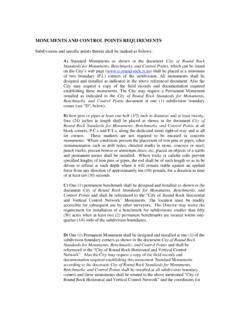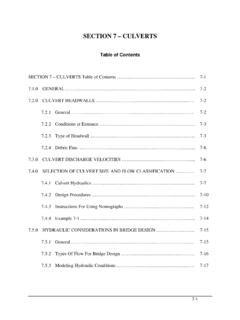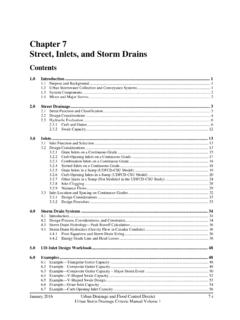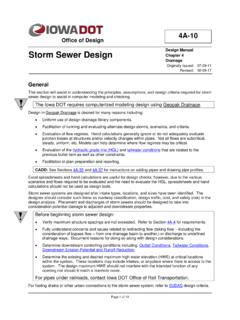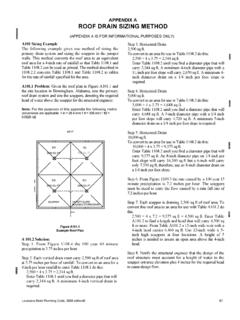Transcription of SECTION 5 – STORM DRAINS - Round Rock, Texas
1 SECTION 5 STORM DRAINS . Table of Contents SECTION 5 STORM DRAINS Table of Contents . 5-1.. GENERAL .. 5-2. DESIGN RULES .. 5-2. DESIGN PARAMETERS .. 5-3. Minimum Grades . 5-3. Maximum Velocities .. 5-3. Minimum Diameter .. 5-3. Roughness Coefficients .. 5-3. FLOW IN STORM DRAINS .. 5-4. Flow Equation Method . 5-4. Nomograph Method . 5-5. HYDRAULIC GRADIENT 5-6. Friction Losses . 5-6. Minor Losses 5-9. Hydraulic Gradient Calculation Table . 5-13. MANHOLES .. 5-15. DEPTH OF COVER .. 5-16. 5-1. Drainage Criteria Manual SECTION 5 - STORM DRAINS . SECTION 5 - STORM DRAINS . GENERAL. The purpose of this SECTION is to consider the hydraulic aspects of STORM DRAINS and their appurtenances in a STORM drainage system . Hydraulically, STORM drainage systems consist of conduits (open or enclosed) in which unsteady and non-uniform flow exists. The design STORM shall be the 25 year STORM with provisions made for the 100 year STORM as noted in SECTION 3 of this Manual.
2 DESIGN GUIDELINES. The following rules are to be observed in the design of STORM drain system components to be located in public right-of-way or public drainage easements in order to promote proper operation and to minimize maintenance of those systems: A. Select pipe size and slope so that the velocity of flow will increase progressively or at least will not appreciably decrease at inlets, bends or other changes in geometry or configuration. B. Do not discharge the contents of a larger pipe into a smaller one even though the capacity of the smaller pipe may be greater due to a steeper slope. C. For all pipe junctions other than a manhole, the angle of intersection between any two flow paths shall not be greater than forty-five (45) degrees. This includes discharges into box culverts and channels. E. No proposed pipe having a diameter greater than fifty (50) percent of the minimum dimension of an existing box culvert shall be allowed to discharge into that box culvert.
3 Exceptions must be justified by structural engineering analysis. G. Pipe shall be reinforced concrete. Concrete pipe shall be manufactured and installed in compliance with the City of Round Rock DACS - Standard Specifications Manual. H. The 25 year hydraulic grade line shall remain six (6) inches below the theoretical gutter flow line of inlets. 5-2. DESIGN PARAMETERS. Minimum Grades STORM DRAINS should operate with velocities of flow sufficient to prevent deposition of solid material. The controlling velocity is near the bottom of the conduit and is considerably less than the mean velocity. STORM DRAINS should be designed to have a minimum velocity of two and one half ( ) feet per second (fps). Maximum Velocities Maximum velocities in conduits are important because of the possibility of excessive erosion of the STORM drain pipe material. Table 5-1 lists the maximum velocities allowed. Table 5-1. Maximum Velocity In STORM DRAINS Type Maximum Permissible Velocity STORM DRAINS (inlet laterals) No limit STORM DRAINS (trunk) 20 fps Minimum Diameter Pipes that are to become an integral part of the public STORM sewer system shall have a minimum diameter of eighteen (18) inches.
4 Roughness Coefficients The coefficients of roughness listed in Table 5-2 are for use in Manning's Equation. 5-3. Table 5-2. Roughness Coefficients "n" For STORM DRAINS Materials of Construction Minimum Design Coefficient Concrete Corrugated-metal Pipe Plain or Coated Paved Invert (Asphalt) Plastic Pipe Smooth Perforated FLOW IN STORM DRAINS . All STORM DRAINS shall be designed by the application of the Continuity Equation and Manning's Equation either through the appropriate charts and nomographs or by direct solution of the equations as follows: Flow Equation Method Q = AV and (Eq. 5-1). Q = ( ) AR2/3S1/2 (Eq. 5-2). where, Q = Pipe Flow, cfs A = Cross-sectional area of flow, ft2. V = Velocity of flow, ft/sec n = Coefficient of roughness of pipe R = Hydraulic radius = A/W p, ft S = Friction slope in pipe, ft/ft Wp = Wetted perimeter, ft 5-4. Nomograph Method Nomographs for determining flow properties in circular pipe, elliptical pipe and pipe- arches are given here as Figures 5-1 through 5-9 in Appendix B of this Manual.
5 The nomographs are based upon a value of "n" of for concrete and for corrugated metal. The charts are self-explanatory, and their use is demonstrated by the following examples in this SECTION . For values of "n" other than , the value of Q should be modified by using the following formula: Qc= Qn/nc where, Qc = Flow based upon nc nc = Value of "n" other than Qn = Flow from nomograph based on n = This formula can be used in two (2) ways. If nc = and Qc is unknown, use the known values to find Qn from the nomograph, and then use the formula to convert Qn to the required Qc. If Qc is one of the known values, use the formula to convert Qc (based on nc) to Qn (based on n = ) first, and then use Qn and the other known values to find the unknown variable on the nomograph. Example 5-1: Given: Slope = ft/ft d = depth of flow = feet D = diameter = 36 inches n = Find: Discharge (Q). First determine d/D = ' ' = then enter Figure 5-1 (in Appendix B of this Manual) to read Qn= 34 cfs.
6 From the formula, Qc= 34 ( ) = cfs. Example 5-2: Given: Slope = ft/ft D = diameter = 36 inches Q = cfs n = Find: Velocity of flow (ft/sec). First convert Qc to Qn so that nomograph can be used. Using the formula Qn= ( )/( ) = 34 cfs, enter Figure 5-1 (in Appendix B of this Manual) to determine d/D = Now enter Figure 5-3 (in Appendix B of this Manual) to determine V = ft/sec. 5-5. HYDRAULIC GRADIENT. In STORM drain systems flowing full, all losses of energy are a function of resistance of flow in pipes or by interference with flow patterns at junctions. These losses must be accounted for by their accumulation along the system from its tailwater elevation at the outlet to its upstream inlet. The purpose of determining head losses is to include these values in a progressive calculation of the hydraulic gradient. In this way, it is possible to determine the hydraulic gradient line which will exist along the STORM drain system .
7 The hydraulic gradient line shall be computed and plotted for all sections of a STORM drain system flowing full or under pressure flow. The determination of friction loss and minor loss are important for these calculations. Friction Losses Friction loss is the energy required to overcome the roughness of the pipe and is expressed as: hf= (29n2 )(V2/2g)L (Eq. 5-3). where, hf = Friction loss, ft n = Manning's Coefficient L = Length of pipe, ft R = Hydraulic radius, ft V = Velocity of flow, ft/sec g = Acceleration due to gravity, 32 ft/sec2. In addition to Equation 5-3, Table 5-3 can be used to determine the friction slope and applied in Equation 5-4. hf= SfL (Eq. 5-4). where, hf = Friction loss, feet Sf = Friction slope, feet = (Q/C)2. L = Length of pipe, feet C = Full flow coefficient from Table 5-3. Q = Discharge, cfs Example 5-3: Given: Discharge Q = 24 cfs, diameter D = 24 inches, the length of pipe L=300 feet and n = Find: The friction loss Hf 5-6.
8 First, from Table 5-3 for D = 24 inches and n = , the full flow coefficient C = 226. Second, the friction slope Sf= (Q/C)2= The friction loss Hf= SfL = feet Table 5-3. Full Flow Coefficient Values for Circular Concrete Pipe D A R. Pipe Area Hydraulic Value of C* for Diameter (square Radius n = n = n = n = (inches) feet) (feet). 8 10 12 15 18 137 124 114 105. 21 206 187 172 158. 24 294 267 245 226. 27 402 366 335 310. 30 533 485 444 410. 33 686 624 574 530. 36 867 788 722 666. 42 1308 1189 1090 1006. 54 2557 2325 2131 1967. 60 3385 3077 2821 2604. 5-7. Table 5-3 (Continued). Full Flow Coefficient Values for Circular Concrete Pipe D A R. Pipe Area Hydraulic Value of C* for Diameter (square Radius n = n = n = n = (inches) feet) (feet). 66 4364 3967 3636 3357. 72 5504 5004 4587 4234. 78 6815 6195 5679 5242. 84 8304 7549 6920 6388. 90 9985 9078 8321 7681. 96 11850 10780 9878 9119. 102 13940 12670 11620 10720. 108 16230 14760 13530 12490.
9 114 18750 17040 15620 14420. 120 21500 19540 17920 16540. 126 24480 22260 20400 18830. 132 27720 25200 23100 21330. 138 31210 28370 26010 24010. 144 34960 31780 29130 26890. * C = ( ) Source: American Concrete Pipe Association. Concrete Pipe Design Manual. 5-8. Minor Losses From the point at which stormwater enters the drainage system at the inlet until it discharges at the outlet, it encounters a variety of hydraulic structures such as manholes, bends, enlargements, contractions and other transitions. These structures will cause head losses which are called "minor head losses.". The minor head losses are generally expressed in a form derived from the Bernoulli and Darcy-Weisbach Equations: h = KV2/2g (Eq. 5-5). where, h = velocity head loss, feet K = coefficient for head loss The following are minor head losses of hydraulic structures commonly found in a STORM drainage system . A. Junction Losses. Equation 5-6 is used to determine the head loss at a junction of two (2) pipes, with the various conditions of the coefficient Kj given in Table 5-4.
10 Hj= (V22- KjV12)/2g (Eq. 5-6). where, V1 = Velocity for inflowing pipe, ft/sec. V2 = Velocity for outflowing pipe, ft/sec. Kj = Junction or structure coefficient of loss. The detailed design information for junction losses can be found in the Bibliography of this Manual, Item 5-10. B. Bend Losses. The minor head loss at a bend results from a distortion of the velocity distribution, thereby causing additional shear stresses within the fluid. The bend loss is considered to be that in excess of the loss for an equal length of straight pipe. The equation to compute the bend loss is: hb= KbV2/2g (Eq. 5-7). The coefficient Kb varies with the angle of the bend. Table 5-4 and Figure 5-11 in Appendix B of this Manual show the different Kb coefficients used in bend losses. 5-9. Table 5-4. Junction or Structure Coefficient of Loss Cases Reference Description Coefficient Figure of Condition Kj A 5-10 Manhole on Main Line with 45 Branch Lateral B 5-10 Manhole on Main Line with 90 Branch Lateral C 5-11 45 Wye Connection or cut-in D 5-11 Inlet or Manhole at Beginning of Main Line or Lateral E 5-11 Conduit on Curves for 90 *.



